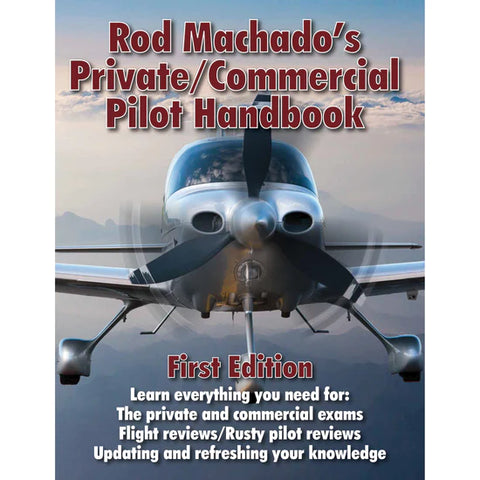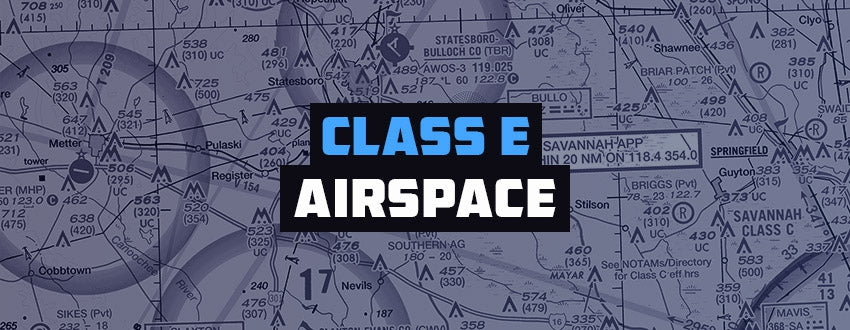Class E airspace may be the most common type of controlled airspace, but is also the least regulated, and perhaps one of the most confusing of the six classes of controlled airspace.
With all its variations and complexities, it is no wonder that many pilots could use a little extra explanation on the logic behind Class E. What are the requirements within Class E? What types of Class E airspace are there? How are they designated and displayed on sectionals? At what altitude is Class E airspace found?
We're cover all of these questions in this guide!
Table of Contents
 What is Class E Airspace?
What is Class E Airspace?
Think of Class E as the “everywhere airspace” or the leftover controlled airspace segments that fill in the gaps around other classes of controlled airspace. This is part of what makes it more varied and more confusing than most other classes.
Class E is a type of controlled airspace that often is controlled by ATC via radar coverage rather than by a local control tower. Clearances are required to enter Class E if you are flying under IFR or Special VFR rules.
Pilots who are flying basic VFR do not require a clearance to be in Class E airspace. Class E airspace below 14,500 feet MSL is depicted on VFR sectionals, IFR en route low altitude, and terminal area charts.
 Requirements of Class E Airspace
Requirements of Class E Airspace
As with other classes of controlled airspace, Class E airspace has specific weather requirements regarding visibility, which are outlined by the FAA. Areas designated as Class Echo airspace have:
- Basic VFR weather minimums, the visibility requirements of 3 miles when flying below 10,000 feet
- Basic VFR cloud clearance minimums of 500 feet below, 1,000 feet above, or 2,000 feet horizontally when flying below 10,000 feet
- Minimum visibility requirements of 5 miles when flying above 10,000 feet
- Cloud clearance minimums above 10,000 feet are 1,000 feet below, 1,000 feet above, and 1 mile horizontally
- No specific equipment requirements
Purpose of Class E Airspace
Class E airspace exists to provide added protection for the separation of IFR and VFR aircraft. It creates a type of airspace in which pilots following visual flight rules do not need special clearances, but IFR pilots intending on using an instrument approach do. This helps Air Traffic Control to safely route IFR pilots through this airspace while minimizing the additional requirements placed on VFR pilots.
Class E Airspace Altitude
Altitude of Class E tends to be confusing initially. Most Class E airspace begins at 1,200 feet above ground level (AGL) and can extend up to FL180 (17,999 feet) if there is not another class of airspace on top of it.
In certain circumstances, Class E can also start at ground level, 700 feet AGL, or another specified altitude. All airspace above FL600 (60,000 feet) is designated as Class E.
Class E Airspace Transitional Area
Class E transitional areas are typically found around individual airports or groups of airports. Transitional areas are types of airspace used to shift between the terminal and en route environments. Transitional areas are indicated on sectionals using a magenta circle. Within the transitional area circle, Class E starts at 700 feet AGL. Outside of the transitional area, Class E airspace starts at 1,200 AGL unless otherwise designated.
Depending on terrain and the rate of climb capabilities of aircraft that will be using the airport, the transitional area may include irregularly shaped extensions connecting to the circular transitional area to provide enough protected airspace for IFR planes to climb up to altitude.
Class E Airspace Surface Area
In certain areas, Class E airspace starts right at ground level. This provides maximum protection for arriving IFR aircraft on a cloudy day at an airport without a control tower. On charts, Class E airspace which starts at the surface is denoted by a dashed magenta line.
When looking at their charts, pilots will sometimes notice an airport surrounded by the magenta ring of a transitional Class Echo airspace with a dashed magenta line cutout in that circle showing a Class E surface area airspace.
In this case, the surface area airspace most likely aligns with an arrival corridor which IFR pilots could be using. Extending the controlled airspace to surface level in this area helps to provide additional protection to Instrument Flight pilots without placing a communications requirement on VFR pilots.
Class E Airspace Around Victor Airways
Victor airways are a type of designated low-altitude straight-line segment airway for IFR pilots. These airways are 8 nautical miles wide, with Class E airspace extending 4 nautical miles on either side of the airway centerline. The Class E airspace surrounding a victor airway begins at 1,200 feet AGL and extends up through 17,999 feet.
Class E En Route Domestic Areas
Pilots will also come across Class E airspace in areas where IFR en route ATC services are required but not otherwise supported by the federal airway structure. These en route Class E areas are denoted on sectionals by a soft blue border around the airspace. Within the border, Class E airspace starts at 1,200 feet AGL.
Class E Airspace Shapes
While many Class E airspaces are circular, Class E can come in different shapes due to terrain, types of aircraft using the airport, and the need to protect approaches and departures from specific runways.
Protected approaches and departures often appear on a chart as rectangular areas connected to the circular Class E airspace. Surface area Class E airspace is usually surrounded by a Class E transition area which gives it a somewhat similar look to the familiar upside-down tiered wedding cake shape of Class B and C airspace.

-
Where does Class E airspace start?
Class E is considered the "Everywhere" space, it starts from the surface and extends. The upper limit is the height of the surrounding Class E floor.
-
What is the difference between Class G and E airspace?
Class G airspace is uncontrolled, whereas Class E is controlled. Class G is referred to as Class Golf airspace while Class E is is called Class Echo.
-
Can you fly VFR in Class E airspace?
Yes, as long as the VFR weather minimums are met.
-
What is the difference between Class C and Class E airspace?
Class C airspace is usually found around airports and requires communication with Air Traffic Control due to the busier airspace, while Class E airspace is generally less restrictive. Class C airspace is referred to as Class Charlie airspace.
 Learn More
Learn More
To understand more of the rationale behind the airspace configuration surrounding different airports, watch fly8ma’s video on the Class E airspace area. He not only explains what Class E airspace is, but also shows examples of Class E airspace on sectionals and talks through the airspace configuration to help flesh out our understanding of the logic behind the once confusing Class E airspace.
For drone pilots who are studying types of airspace, The Complete Remote Pilot book from ASA is another excellent resource, and the ASA’s Pilot’s Handbook of Aeronautical Knowledge offers all pilots a refresher on airspace and many other important topics.
Check out our Flight Training Material collection for hundreds of books and training material.

|
Rod Machado's Private Pilot/Commercial HandbookLearn to fly from a book that has personality with Rod Machado’s "Private Pilot/Commercial Pilot Handbook." In addition to having everything you need to know to become a knowledgeable and competent pilot, this book is full of wit, humor, analogies, and fun. |









1 comment
William Queen
Outstanding presentation on air spaces. Keep up the great work!